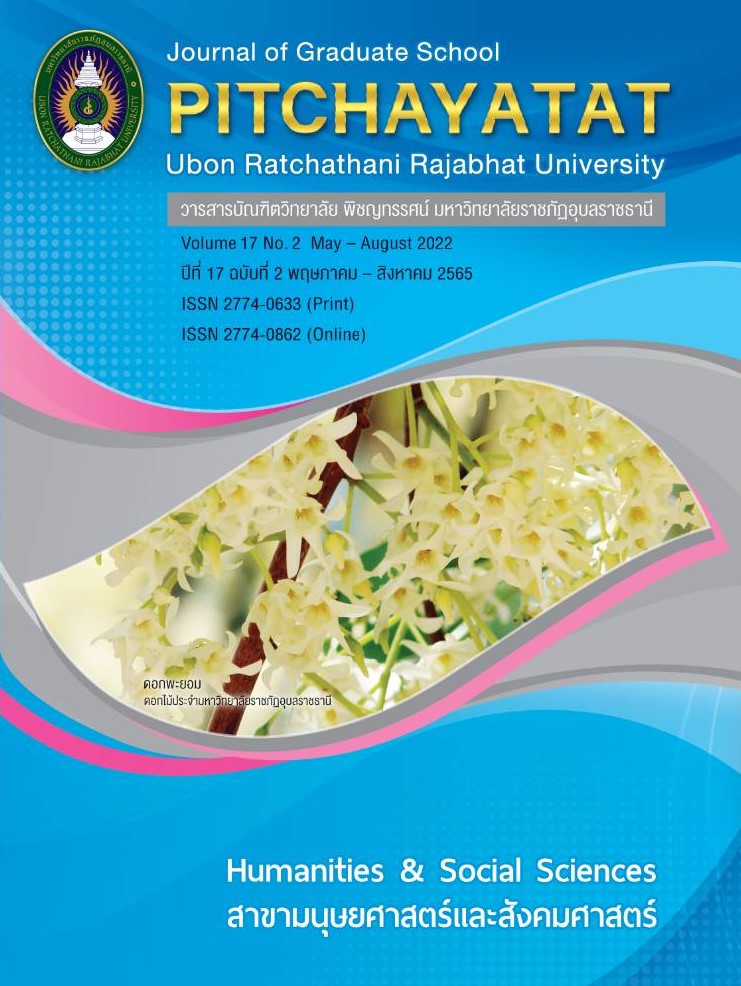ผลการจัดการเรียนรู้รายวิชาภาษาญี่ปุ่นโดยใช้แนวคิดห้องเรียนกลับด้านร่วมกับการสอนแบบตรงในชั้นเรียน เพื่อพัฒนาทักษะการฟัง-พูดของนักเรียนชั้นมัธยมศึกษาปีที่ 4 แผนการเรียนภาษาอังกฤษ-ภาษาญี่ปุ่น
คำสำคัญ:
ห้องเรียนกลับด้าน , การสอนแบบตรง , ทักษะการฟัง-พูดภาษาญี่ปุ่น , ภาษาญี่ปุ่นบทคัดย่อ
การวิจัยนี้มีวัตถุประสงค์เพื่อพัฒนาทักษะการฟัง-พูดภาษาญี่ปุ่น โดยจัดการเรียนรู้ตามแนวคิดห้องเรียนกลับด้านร่วมกับวิธีการสอนแบบตรงในชั้นเรียน กระบวนการวิจัยใช้ระเบียบวิธีวิจัยกึ่งทดลอง โดยผู้วิจัยพัฒนาแผนการจัดการเรียนรู้รายวิชาภาษาญี่ปุ่น ตามแนวคิดห้องเรียนกลับด้านร่วมกับการสอนแบบตรงเพื่อส่งเสริมทักษะการฟัง พูดภาษาญี่ปุ่น โดยได้รับการตรวจสอบจากผู้เชี่ยวชาญด้านการสอนภาษาญี่ปุ่นว่ามีความเหมาะสมในระดับมากที่สุด และนำไปใช้จัดการเรียนรู้กับกลุ่มทดลอง คือ นักเรียนชั้นมัธยมศึกษาปีที่ 4/4 แผนการเรียนภาษาอังกฤษ ภาษาญี่ปุ่น โรงเรียนสงวนหญิง ภาคเรียนที่ 2 ปีการศึกษา 2564 โดยการเลือกแบบเจาะจง จำนวน 21 คน โดยเปรียบเทียบกับนักเรียนกลุ่มควบคุม ที่ได้รับการจัดการเรียนรู้ด้วยวิธีปกติ รวบรวมข้อมูลด้วยแบบทดสอบการฟังภาษาญี่ปุ่น แบบทดสอบการพูดภาษาญี่ปุ่น สำหรับนักเรียนชั้นมัธยมศึกษาปีที่ 4 แผนการเรียนภาษาอังกฤษ ภาษาญี่ปุ่น และศึกษาความพึงพอใจของกลุ่มทดลองด้วยแบบสอบถามความพึงพอใจของนักเรียนที่มีต่อการเรียนรู้ตามแนวคิดห้องเรียนกลับด้านร่วมกับการสอนแบบตรงเพื่อส่งเสริมทักษะการฟัง พูดภาษาญี่ปุ่น สถิติที่ใช้ ได้แก่ ค่าเฉลี่ย ส่วนเบี่ยงเบนมาตรฐาน และการทดสอบที
ผลการวิจัยพบว่า
นักเรียนกลุ่มทดลองมีทักษะการฟังภาษาญี่ปุ่นสูงกว่ากลุ่มควบคุม อย่างมีนัยสำคัญทางสถิติที่ระดับ .001 และกลุ่มทดลองมีทักษะการพูดภาษาญี่ปุ่นสูงกว่ากลุ่มควบคุม อย่างมีนัยสำคัญทางสถิติที่ระดับ .001 หลังจากการจัดการเรียนรู้ตามแนวคิดห้องเรียนกลับด้านร่วมกับการสอนแบบตรง และนักเรียนกลุ่มทดลองมีความพึงพอใจสำหรับการเรียนตามแนวคิดห้องเรียนกลับด้าน ร่วมกับการสอนแบบตรง อยู่ในระดับความพึงพอใจมาก
เอกสารอ้างอิง
กิตติชัย สุธาสิโนบล. “ห้องเรียนกลับด้าน,” สารานุกรมศึกษาศาสตร์ คณะศึกษาศาสตร์ มหาวิทยาลัยศรีนครินทรวิโรฒ. 50, 1 (2558): 116-127.
เกรียงไกร สกุลประเสริฐศรี และจุฑารัตน์ วิบูลผล. “ผลของการสอนภาษาอังกฤษโดยใช้แนวคิดการเรียนรู้แบบห้องเรียนกลับด้านที่มีต่อความสามารถในการพูดภาษาอังกฤษเพื่อการสื่อสารและแรงจูงใจในการเรียนภาษาอังกฤษของนักเรียนมัธยมศึกษาตอนปลาย,” ครุศาสตร์. 44, 3 (16 พฤษภาคม 2559): 29-45.
ณัฐกานต์ เดียวตระกูล. “การใช้รูปแบบห้องเรียนกลับทางในการจัดการเรียนการสอนภาษาอังกฤษในระดับอุดมศึกษา,” ศรีปทุมปริทัศน์ ฉบับมนุษยศาสตร์และสังคมศาสตร์. 17, 2 (กรกฎาคม-ธันวาคม 2560): 137-145.
นิชาภา บุรีกาญจน์ และเอมอัชฌา วัฒนบุรานนท์. “ผลการจัดการเรียนรู้วิชาสุขศึกษาโดยใช้แนวคิดแบบห้องเรียนกลับด้านที่มีผลต่อความรับผิดชอบและผลสัมฤทธิ์ทางการเรียนของนักเรียนมัธยมศึกษาตอนต้น,” An Online Journal of Education. 9, 2 (เมษายน-มิถุนายน 2557): 768–782.
นิภา กู้พงษ์ศักดิ์. “ผลสัมฤทธิ์ทางการเรียนวิชาภาษาไทยเพื่อการสร้างสรรค์ และความพึงพอใจต่อวิธีการสอนแบบห้องเรียนกลับด้าน,” Journal of Graduate Studies Valaya Alongkron Rajabhat University. 11, 1 (มกราคม-เมษายน 2558): 55-67.
พิมพ์ประภา พาลพ่าย. การใช้สื่อสังคมตามแนวคิดห้องเรียนกลับด้าน เรื่อง ภาษาเพื่อการสื่อสาร เพื่อส่งเสริมผลสัมฤทธิ์ทางการเรียนของนักเรียนชั้นประถมศึกษาปีที่ 6. วิทยานิพนธ์ศึกษาศาสตรมหาบัณฑิต มหาวิทยาลัยเกษตรศาสตร์, 2557.
วิจารณ์ พานิช. ครูเพื่อศิษย์สร้างห้องเรียนกลับทาง. พิมพ์ครั้งที่ 2. กรุงเทพฯ: มูลนิธิสยามกัมมาจล, 2556.
วิภาดา ประสานทรัพย์. นวัตกรรมการสอนภาษาอังกฤษประเภทวิธีสอน. (ออนไลน์) 3 เมษายน 2559 (อ้างเมื่อ) 14 พฤศจิกายน 2563. จาก: http://www.eledu.ssru.ac.th/wipada_pr/mod/resource/view.php?id=20
ยุพกา ฟูกุชิม่า. “ทัศนคติของผู้เรียนต่อการบรรยายด้วยภาษาญี่ปุ่นของผู้สอนชาวไทยในรายวิชาการอ่านภาษาญี่ปุ่นขั้นสูง,” เครือข่ายญี่ปุ่นศึกษา. 9, 1 (มิถุนายน 2562): 25-48.
ศึกษาธิการ, กระทรวง. ตัวชี้วัดและสาระการเรียนรู้ภาษาญี่ปุ่นและภาษาเยอรมัน. กรุงเทพฯ: โรงพิมพ์ สกสค, 2551.
โสฬศา สาตพร. ภาษาศาสตร์เบื้องต้น = introduction to linguistics : คู่มือการศึกษาสาขาวิชาศิลปะศาสตร์. นนทบุรี: มหาวิทยาลัยสุโขทัยธรรมาธิราช, 2554.
Mattinez, R. and M.C. Ruiz-Jimenez. “Improving students’ satisfaction and learnig performance using flipped classroom,” The International Journal of Management Education. 18, 3 (July 2020): 1-8.
Millsaps, J. ESL Teaching Methods: What Is The Direct Method?. (online) 3 march 2020 (cited 14 November 2020). Available: https://blog.alo7.com/esl-teaching-methods-what-is-the-direct-method/
Prefume, Y. Exploring a flipped classroom approach in a Japanese language classroom: a mixed methods study. Doctor’s Thesis Department of Curriculum and Instruction Baylor University, 2015.
ดาวน์โหลด
เผยแพร่แล้ว
รูปแบบการอ้างอิง
ฉบับ
ประเภทบทความ
สัญญาอนุญาต
ลิขสิทธิ์ (c) 2022 วารสารบัณฑิตวิทยาลัย พิชญทรรศน์ มหาวิทยาลัยราชภัฏอุบลราชธานี

อนุญาตภายใต้เงื่อนไข Creative Commons Attribution-NonCommercial-NoDerivatives 4.0 International License.
บทความทุกเรื่องได้รับการตรวจความถูกต้องทางวิชาการโดยผู้ทรงคุณวุฒิภายนอกอย่างน้อย 3 คน ความคิดเห็นในวารสารพิชญทรรศน์เป็นความคิดเห็นของผู้นิพนธ์มิใช่ความคิดเห็นของผู้จัดทำ จึงมิใช่ความรับผิดชอบของวารสารพิชญทรรศน์ และบทความในวารสารพิชญทรรศน์สงวนสิทธิ์ตามกฎหมายไทย การจะนำไปเผยแพร่ต้องได้รับอนุญาตเป็นลายลักษณ์อักษรจากกองบรรณาธิการ





